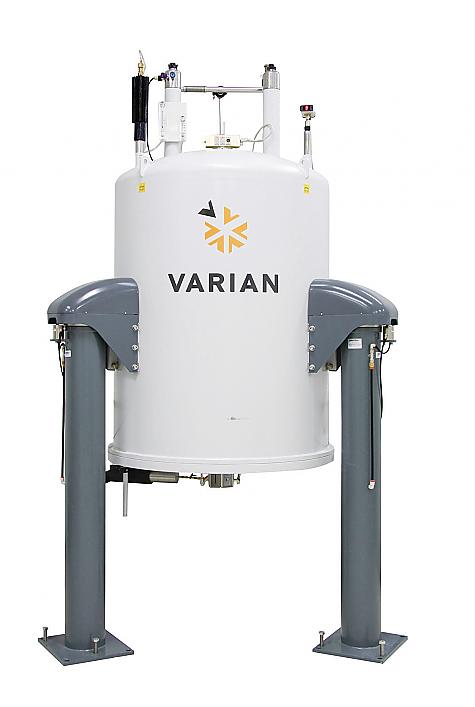600 MHz FT-NMR (Varian) | 600 MHz 핵자기 공명 분광기

| 연구실/분야 | |||
|---|---|---|---|
| 모델명 | VNMRS600 | ||
| 제조사 | Varian | ||
| 담당자 | 한선필 | ||
| 연락처 | 052-217-4174 / okno1234@unist.ac.kr | ||
| 예약 가능여부 | 가능 | ||
| 예약단위 | 10min | 1일최대예약시간 | 24hr |
| 예약Open(~일 전) | 5일전 | 예약취소불가(~일 전) | 1시간전 |
| 장비위치 | 102동 B119호 | ||
-
Description
핵자기 공명 분광기는 유기분자, 고분자 물질 및 생체 분자 등의 화합물 구조를 결정하는 기기이며, 정성 및 정량 분석에 이용된다. 자기장 내에서 일정한 회전축을 갖는 원자핵에 라디오파를 가해주면 무질서하게 있던 핵들이 높은 에너지 준위로 여기된다. 이때 발생하는 원자핵의 핵자기 공명 현상을 이용하여 시료 내 핵 주위의 화학적 환경 및 이웃 원자와의 스핀 결합에 대한 정보를 얻을 수 있다.
NMR is a technique for determining the structure of most organic and some inorganic molecules. NMR studies a magnetic nucleus by aligning it with a very powerful external magnetic field and disturbing this alignment using an electromagnetic field. Different atoms within a molecule resonate at different frequencies at a given field strength.
https://ucrf.unist.ac.kr/en/category/data/technical-library/
1) Varian 600 MHz FT-NMR Operation Manual
2) DOSY NMR Manual
3) 2D NMR Manual
4) SOP of Bruker 400 MHz FT-NMR
https://ubts.co.kr/
NMR 이론 및 실습관련 동영상 교육자료 (NMR Theory and Practice video)
- 이론, 장비사용법, Mnova processing 등 -
Specifications
• Premium shielded 14.09 T (600 MHz) magnet
• 3 channel console
Ch1: 100 Watt
Ch2: 300 Watt
Ch3: 300 Watt
• Available probes
- 5mm Dual broad band auto X probe
Ch1: 1H, 19F
Ch2: 15N ~ 31P
Sample amount: 400 ~ 700 µl
Temperature: -80 ~ 130 °C
Gradient strength: 0.06 T/m (<2.5*10^-11 m^2/s)
- Automated triple resonance probe
Ch1: 1H
Ch2: 13C
Ch3: 15N
Sample amount: 400 ~ 700 µl
Temperature: -20 ~ 80 °C
- 5 mm double resonance MAS solid probe (Stator 파손으로 수리 중)
Ch1: 1H, 19F
Ch2: 15N ~ 31P
Spinning rate: 5~10 kHz (Max: 12 kHz)
Sample amount: ~ 100 mg (fine powder) or KBr mixture
Temperature: RT
- 1.6 mm HXY fast MAS triple resonance probe (수리완료)
Ch1: 1H, 19F
Ch2: 15N ~ 31P
Sample amount: 10 ~ 20 mg (fine powder) or KBr mixture
Spinning rate: 8~35 kHz (Max 40 kHz)
Temperature: 0 ~ 60 C
- Nano TM probe (Similar Bruker HR-MAS probe)
Spinning rate: 2~2.5 kHz (Maximum 3 kHz)
Sample amount: 40 µl (gel or para-magnetic sample)
Temperature: 0 °C ~ 50 °C
• XR - 401(temperature control unit)
Temperature: -60 ~ 100 °C
• 5mm DB auto-X probe Tune & Match range = 31P (40%) ~ 15N (10%)
• Smart of i-Probe (Bruker) / Royal probe (Jeol) = 31P(40%) ~ 109Ag (4.65%)
ex) 5mm DB auto-X probe
31P(40%): O
13C (25%): O
15N(10%): O
35Cl(9.7%): O
33S (7.6%): X ->Find 31P(40%) ~ 109Ag(4.65%) Probe
14N(7.2%): X ->Find 31P(40%) ~ 109Ag(4.65%) Probe
25Mg(6.1%): X ->Find 31P(40%) ~ 109Ag(4.65%) Probe
https://kodu.ut.ee/~laurit/AK2/NMR_tables_Bruker2012.pdf
https://www.pascal-man.com/periodic-table/periodictable.shtml
• NMR solvent and Referencing (+Quantitative NMR)
1. Sample + NMR solvent (CDCl3, D2O, DMSO-D6, etc.) + reference compound
2-1. Sample + NMR solvent (CDCl3, D2O, DMSO-D6, etc.)
2-2. Reference sample
3. Coaxial sample tube (Evans method) - Reference or NMR solvent in Inner tube / Sample in Outer tube
-> Possible to measure Non mixture with NMR solvent
• Sample volume = 500ul (400 ~ 700 ul)
• Sample concentration
1. 1H: 0.05 mM ~ 10 mM (Too high concentration cause line-broadening effect)
2. 13C, 2D NMR(COSY, NOESY, TOCSY, etc.): 10 mM ~ 100 mM
3. 15N, 17O, Hetero 2D NMR (HSQC, HMBC, HMQC, etc.): 100 mM <
Ex)
Sample A (MW=200), 0.05 mg / 500 ul = 0.5 mM (mmol/L) = 100 ppm (ug/ml)
Sample A (MW=200), 1 mg / 500 ul = 10 mM = 2000 ppm
Sample B (MW=500), 25 mg / 500 ul = 100 mM
• Degassing
Oxygen (Paramagnetic) -> Short T1&T2 relaxation-> Quench NMR signal -> Purge N2 or Ar gas
• Doping agent (add Paramagnetic material)
GdCl3 or CuSO4 (Polar) / Cr(acac)3 (Non-Polar) -> Short T1 & T2 relaxation -> Quench NMR signal -> Save time!
1H (1mM)
13C (25-50mM)
• Sample tube
Wilmad (Thin wall): 527-PP-7 Temp: O, MW> 1500 (Large or Polymer), To use Quantitative NMR or Coaxial tube (Non-mix NMR solvent)
Wilmad (Economy): WG-1228-7 Temp: X (only RT), MW < 1500 (Medium)
Wilmad (Cheap): WG-1000-7 Temp: X (only RT), MW < 250 (Small)
https://www.bkinstruments.co.kr/Products/list.asp?page=1&s_type=&s_keyword=&p_cate=10&p_cate2=1018
-
Applications
• Structural elucidation of chemicals
• Structural determination of biomolecules (DNA, RNA, proteins, peptides, etc.)
• Study of dynamic process
• Drug design
Dual broad band auto X probe
Detectable nuclei: 1H, 7Li, 9Be, 11B, 13C 17O, 19F, 23Na, 27Al, 29Si, 31P, 35Cl, 119Sn etc